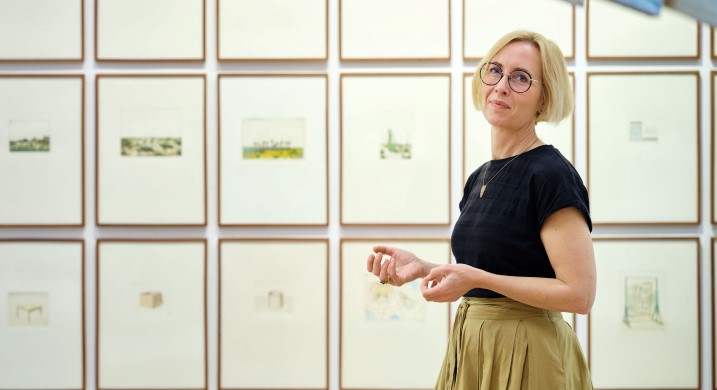Read more about A Posthumous Journey into the Future
Read more about A Posthumous Journey into the Future in a text written by the curator of the exhibition, Rebecka Wigh Abrahamsson.
 Rebecka Wigh Abrahamsson in front of Sten Eklunds svit Kullahusets hemlighet. Photo: Pär Fredin.
Rebecka Wigh Abrahamsson in front of Sten Eklunds svit Kullahusets hemlighet. Photo: Pär Fredin.
The Secret of Kullahuset became a door to another world
It could have been different. If fossil-based society had not taken over and consumerism had not flourished. Back in 1971, the artist Sten Eklund expressed an uneasy sensation that something was wrong in our society. There is no room in language to express feelings, Eklund wrote. The series The Secret of Kullahuset, comprising 53 hand-coloured etchings, opened the door to another world, and inverted the civilisational logic of exploitation and rational decisions. A romantic perspective on world.
Is it possible for fiction to create another kind of understanding?
In the exhibition A Posthumous Journey into the Future, eight internationally active artists together explore Sten Eklund’s Kullahuset series and how fiction and speculative thinking can generate a different form of understanding of the cultural and planetary crisis we are currently in the midst of. A future that is cancelled or postponed, in many ways. Sten Eklund’s fictional visual narrative is set in the fateful year of 1849, just before Crystal Palace was built and the World Fair in London opened; this is often described as the breakthrough of consumerism and early industrialism.
An offer of another perspective on the world
A Posthumous Journey into the Future aims to offer a perspective on the world where time and space are dissolved, where the historical link between “discovery, conquest and knowledge”, which the author and philosopher Édouard Glissant discusses, can be challenged. Metaphorically, Glissant writes that there are no longer five continents, only archipelagos. He proposes an archipelagic approach, where the sensory and imaginary world is central. The anthropologist and philosopher Bruno Latour voices similar criticism, writing, “To be modern, by definition, is to project onto the others at every turn the conflicts between the Local and the Global, between the archaic past and the future.”
There is room for both sorrow and re-enchantment
In video installations, text-based works, objects and prints, we travel backwards in time in the exhibition, allowing ourselves to visit microbiotic worlds, computer-generated places, magnetic zones and dream states. Here, there is room to mourn the species on the verge of extinction, and for past and present extractivism. The imaginary also offers healing processes – a re-enchantment of the world, where the link to an archaic past is still perceptible. Several works of art also exist in the interstice, the chasm of unreality and vertigo that we experience briefly in everyday life, when the extent of the climate crisis opens before us.

